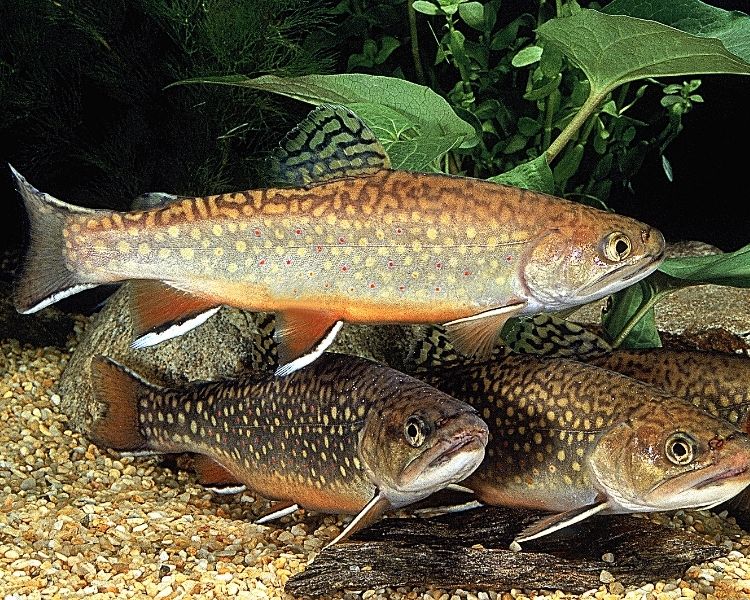The Eastern Brook Trout, Salvelinus fontinalis, is also commonly referred to as the Brookie, Squaretail, or Speckled Trout, is one of the most widespread and abundant cold-water fish found in Maine. It favors cool, clear, well-oxygenated water to spawn, nurse, and live into adulthood successfully.
Brook Trout can be found in various habitats ranging from the most insignificant brooks to the largest lakes, as long as the conditions are suitable for their survival and free from excessive predation. They are very sensitive to interspecies predation, especially during the first year or two of their lives. That being said, can brook trout spawn survive and thrive in ponds?

Are Brook Trout Capable of Spawning in Ponds?
The short answer is yes. The long answer is a little more complex. While Brook trout can survive well enough in ponds, they are very particular when it comes to breeding. Brook trout lay their eggs where there is flowing water because their eggs, or roe, need it to successfully hatch. So, where does this leave ponds?
Some ponds have inlets, outlets, or upswells that effectively fulfill this particular condition. When breeding season comes around, female brook trout will build structures known as redds. These are small pebbles or gravel that she sweeps up into a ‘wall’ and proceeds to lay her eggs away from the flowing water. This is to prevent having her eggs swept downstream by the water’s current. The male then fertilizes the eggs, which typically number in the hundreds.
The fact that most ponds will not have any area that provides the suitable conditions of flowing water and gravelly bottoms is the main reason they are not considered ideal locations for brook trout breeding. Even in cases where there is an upswell, pond bottoms tend to be muddy, with no gravel or pebbles to build redds out of.
Male and female brook trout may go through the motions of building redds, laying eggs, and fertilizing them, but eggs need flowing water to hatch out of their eggs, so they will not successfully spawn.
With that being said, there are many questions surrounding the breeding and spawning habits of brook trout, and we’ll try and answer some of them here. Let’s get right into it.
What Triggers Brook Trout to Spawn?
The spawning behavior of brook trout is mostly determined by changes in water temperatures in their habitat. They prefer cooler waters, so they typically begin spawning once the warm summer weather gives way to the cooler temperatures of the fall. You can expect them to start spawning once water temperatures come down to 40-49 degrees Fahrenheit.
At What Age Do Brook Trout Begin Breeding?
Brook trout are relatively fast breeders and can reach sexual maturity within a few months. A brook trout born during springtime can reach sexual maturity and be ready to breed by the same year’s fall. The female brook trout will reach breeding age faster than the male of the species. A useful rule of thumb is that females are ready to breed in Year 1 while males will be ready by Year 2.
Also Read: How Long Does it Take for Catfish To Mature?
Do Trout Feed When Spawning?
The feeding behaviors of brook trout spawn will undergo some change during spawning. The fall spawning season will see them reduce their feeding as they will be more focused on reproduction than feeding. For this reason, you might not have as much luck as a fisherman during this season as they will be biting less, although this doesn’t mean that you can’t catch them at all using bait.
What is the Lifespan of a Brook Trout?
Brook trout are fast growers and typically have short lifespans. They will rarely live beyond three years in their natural habitat, although some may live to 4 or 6 years. They tend to have even shorter lifespans when bred in captivity, with few survivors making it past two years.
How Old is a 12-inch Brook Trout?
Because the size of brook trout varies so widely depending on their food sources, water temperatures, and productivity, a 12-inch brook trout might be anywhere between 2-4 years. In Maine, for example, the average size of a 3-year-old brook trout is 13.3 inches.
What is Considered a Big Brook Trout?
This will depend on the conditions under which it is growing. A sexually mature trout might only be 6 inches long in some regions. Generally speaking, trout exceeding 15 inches can be considered a large brook trout.
How Big is a 1-year-old Brook Trout?
Brook trout grow relatively quickly. While the size of a year-old brook trout will vary depending on the conditions they are living under, an average 1-year old might range between 4 and 7 inches.
How Do You Tell the Difference Between a Male and Female Brook Trout?
Brook trout are largely similar in size and coloration between the sexes, but certain features in the males differentiate them. In the Fall season, you will observe that the bellies and fins of the males turn a bright orange color. In addition to this unique change, male brook trout develop an upward hook on their lower jaws as they age.
This protuberance is known as a kype and serves as an additional weapon to their saw-like teeth, which they use when fighting other males during the breeding season. The males of eastern brook trout species also show bright white markings on the front edges of their fins.
How Many Brook Trout Spawn Eggs Survive on Average?
The survival rate of brook trout eggs will vary depending on the environmental conditions and water temperature they are laid in. Young females might only lay 100 eggs per season, but more mature trout can lay 400-600 eggs at a time, as long as they are fit and healthy.
As long as the eggs are well covered with gravel or other material that will protect them from predation and prevent them from being carried away by the current, most of them will successfully hatch.
Final Thoughts
Brook trout are a hardy fish species, and they have thrived in the rivers, streams, and lakes of Maine for centuries. While they do well under ideal conditions, ponds fail to meet the water flow and gravel requirements that their eggs need to successfully spawn. Some ponds might have inlets, outlets, and upswells that successfully meet these requirements, but these are the exceptions rather than the rule.
